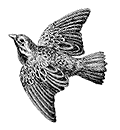 |
 |
 |
||||||||||||||||
|
UB Daily UB Exec Arts & Letters Daily Academic Partners |

Volume 11, No. 6—September 2001
QUESTION: WHAT DO VLADIMIR Nabokov, Richard Feynman, Olivier Messiaen, Wassily Kandinsky, and Nikola Tesla have in common? Answer: They all were, or at least claimed to be, synesthetes. Each of them, in other words, experienced sensory crossovers. Nabokov had "colored hearing"; the sounds associated with letters of the alphabet evoked for him specific hues (the b sound, he wrote in Speak, Memory, was "burnt sienna," whereas s was "a curious mixture of azure and mother-of-pearl"). Tesla, a pioneer in the field of electricity, could discern the flavor of certain sights; looking at small squares of paper in a dish of liquid would fill his mouth with a horrible taste. And so on. Synesthesia, a recognized phenomenon for the last three hundred years or so, enjoyed a special vogue in the late nineteenth century among spiritualistically inclined artists. Today about one person in two thousand is gifted—or cursed—with sensory crossover; that, at any rate, is the usual estimate in the scientific literature. About twenty forms of synesthesia have been reported. The most common of these involve various written letters or numbers triggering colors, which are either seen in the mind's eye or projected outside the body (usually within arm's reach). In rarer cases, synesthetes say they can see the fragrance of a flower, or taste the note of a trumpet, or even hear the decor of the room they are in. One synesthete reported that the sensation of pain she felt when she tore a ligament in her leg turned the whole world orange. It is tempting to dismiss all this as the product of overvivid imaginations. "The confessions of a synesthete must sound tedious and pretentious to those who are protected from such leakings," Nabokov observed. Which of us, after all, has not tasted "sharp" cheese or seen a "loud" color or felt "bitter" cold? Perhaps, one might think, synesthetes just need a little ironic distance from their metaphors. When it comes to deciding whether synesthesia is for real, traditional philosophy isn't a great deal of help. It is conceptually impossible for the synesthete to be mistaken about the subjective experiences he reports, since they are directly present to consciousness. If I sincerely declare that I see blue when I taste beef, then from a philosophical point of view I am as infallible as the pope. For synesthesia to be scientifically interesting, it would have to have some measurable consequences. And it turns out that it does. To begin with, people who report synesthetic experiences tend to be remarkably consistent over time. In one 1993 study, synesthetes were 92 percent consistent in linking particular colors to sounds after a full year, whereas non-synesthetes, when asked to come up with such color associations, could manage only 37 percent consistency after a mere week. Synesthesia also seems to have an effect on normal perception, sometimes actually improving perceptual performance. In one recently published study, those synesthetes for whom numbers triggered colors were instantly able to detect patterns in a black-and-white chart of numerals, patterns that became apparent to non-synesthetes only after several seconds of looking. The most concrete evidence for the reality of synesthesia, however, comes from brain-scanning technologies. Images of the brains of synesthetes who report colored hearing, for example, show increased activation of color-processing areas of the cortex in response to sound. Do synesthetes, then, have crossed wires inside their skulls? Some researchers think so. One hypothesis, advanced by the University of Cambridge psychologist Simon Baron-Cohen, is that synesthesia arises from an overabundance of neural connections in the brain. It is possible that at birth we all experience the world synesthetically with a single undifferentiated sense: Infants less than a year old, for example, show a very similar neural response to a bright light and a loud sound. But as the brain develops with age, many neural connections get pruned away, and the senses begin to operate independently of one another. In synesthetes, the idea goes, this pruning process does not get carried out completely, possibly for genetic reasons (synesthesia is known to run in families). Appealing as this hypothesis may seem, there is one interesting datum with which it does not square: the fact that certain psychedelic drugs can induce temporary synesthesia. It is hard to believe that a hit of LSD could cause new neural connections to sprout and then vanish within the space of a few hours. Maybe synesthetes have the same brain architecture as non-synesthetes, but it just functions differently. Peter Grossenbacher, a scientist at the National Institute of Mental Health, thinks synesthesia has something to do with the interface between sensation and perception. Normally, the brain keeps the right sort of sensory signals on the right sensory-processing channels. Auditory information, for example, is inhibited from flowing along the channel to the visual center. But in synesthetic brains, Grossenbacher conjectures, this inhibition somehow breaks down, allowing the different senses to get jumbled. Whatever its underlying mechanism, synesthesia seems to make reality a tad more interesting, sort of like an everyday fantasia. Some synesthetes say that giving it up would be like seeing the world in black and white. As for us normal, sense-segregated types, we must take our Nabokovian experiences where we can find them. When a secretary places me on hold, I have noticed, certain kinds of piped-in music cause me to see red and feel a headache. JIM HOLT |

|
||||||||||||||||
| If you have problems accessing or using any area of this site, please contact us at web@linguafranca.com.
Copyright © 2001 Lingua Franca, Inc. All rights reserved.
|
||||||||||||||||||